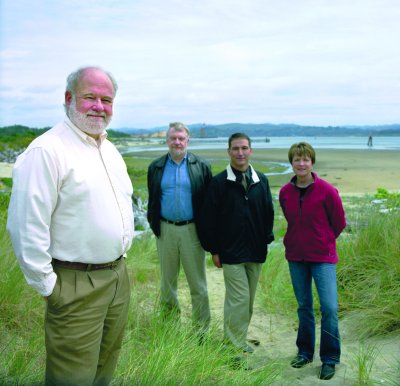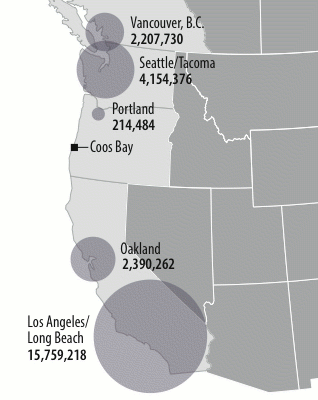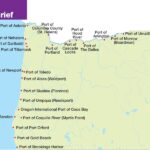 It won’t be easy, but Oregon’s coastal ports are in a position to play a major role in the next wave of local and international shipping.
It won’t be easy, but Oregon’s coastal ports are in a position to play a major role in the next wave of local and international shipping.
 From left: Coos Bay port officials Martin Callery, Dan Smith, Brady Scott and Kaddy McKeown at the port site. From left: Coos Bay port officials Martin Callery, Dan Smith, Brady Scott and Kaddy McKeown at the port site.Photo by Jon Meyers |
OREGON’S PORTS: Possibilities and problems
Connecting the dots
It won’t be easy, but Oregon’s coastal ports are in a position to play a major role in the next wave of local and international shipping.
By Abraham Hyatt
Tiny, quiet and often economically depressed, Oregon’s coastal ports have spent the last few decades slipping into a sleepy obscurity. No fish. No timber. No money.
But they’re far from forgotten. Hundreds of miles from Oregon, the nation’s largest ports are running out of space for the millions of shipping containers that arrive each year. Major highways already have run out of room for more trucks.
And so little ports along the Oregon coast are attracting attention. Last year the Danish company A.P. Moller-Maersk — one of the largest container-shipping firms in the world — began talking with the Port of Coos Bay about building an international shipping terminal that would handle volume similar to ports like Seattle, Tacoma and Oakland. The price tag is estimated between $300 million and $700 million.
Coos Bay is the only harbor on the West Coast of the United States that can be made deep enough for that size of a project. (Two locations in British Columbia and Mexico are the only others in western North America.)
However, Oregon’s other coastal ports aren’t being ignored. Officials at the state’s community development agency want to see smaller coastal ports grow to a point where they can accommodate the type of local shipping that could take trucks off highways, thereby easing congestion and improving air quality.
The state doesn’t have the research or numbers to show exactly what kind of impacts little ports could make on transportation needs. And the reality is that it’s going to take a lot of money to make anything happen. The Coos Bay project (which was awaiting a Senate vote in mid-June) — would provide $60 million for preparatory channel-deepening work. And little ports, some of which are bogged down by multi-million dollar debt loads and political infighting, can only dream about the kind of money they’d need to expand infrastructure.
Regardless of where funding comes from — either from the private sector or state and local agencies — Oregon’s coastal ports are poised to join an interconnected transportation web that extends beyond the major ports and freeways and into the smallest corners of the coast.
 TEUs in 2006Coos Bay would be a comparatively small port; at most it would handle 2 million TEUs (one TEU equals one 20-foot container) a year. But as major ports reach maximum capacity, it would play a crucial role in relieving pressure. |
SHORT-SEA SHIPPING, using coastal and inland waterways to move commercial goods via barge or ship, is a hot topic in transportation circles these days. It takes trucks off already overloaded highways and improves air quality. Not surprisingly, the federal Maritime Administration loves the practice and has been pushing to expand it beyond the few places it’s already used, like the Mississippi, the Gulf of Mexico and, in limited amounts, on the Columbia River.
Oregon state officials are also very interested for one simple reason: Multiple estimates show both ports and major highways running out of room in the next two decades, creating an economic ripple effect around the nation. “From a transportation perspective, we see the economic benefits when short-sea shipping kicks in. The larger state interest is on transportation because that’s what’s going to eat everyone’s lunch eight to 10 years from now,” says Dave Harlan, manager of ports and public policy with the state’s Oregon Economic and Community Development Department.
Harlan and others say ports such as Brookings and Astoria could very well be a part of a short-sea shipping transportation web. That could be an economic godsend to the ports. In 2002, Brookings took out state loans to build several ill-conceived projects that port officials hoped would buoy the commercial fishing industry, which brings in about 3.2 million pounds of fish and crabs to the port each year. There was never enough business to keep those facilities running. Now they’re shuttered and the port is struggling to make payments on the $7.5 million it owes.
In Astoria, legal bills and environmental fines stemming from a bungled dredging project in 2005 have decimated the port’s savings, with millions of dollars more in outstanding debts awaiting it in the coming years. Controversy over its financial affairs, the dredging project and the port’s approval of a liquefied natural gas facility has mired the port in acrimonious political debate. The port’s executive director was fired earlier this year. In a May election, voters replaced half of the port’s commissioners.
So where do those ports stand on short-sea shipping? In Astoria, recently elected commissioner Kathy Sanders says that it’s crucial for the port to be planning how local shipping is going to affect the port. But outgoing president Don McDaniel thinks the port doesn’t have enough land to build the necessary facilities.
In Brookings, port executive director Dave Scott worries about the cost associated with deepening the channel and improving the jetties. “But as problems with roads increase and the price of fuel increases,” he admits, “anything becomes possible.”
The answer to how to fund shipping projects appears to be interconnected with some of the woes that ports have faced. According to Harlan, over the past 20 years small ports have been left to themselves by the state. “Our concern is that the business model for ports is a little broken,” he says.
To fix the broken parts, Harlan wants to have all ports create a formalized business plan. He doesn’t have a lot of specifics for that plan. But the goal would be twofold: force some ports to address their own outstanding financial questions, and give the state a clear picture of which port needs what kind of money, thereby allowing it to prioritize freight mobility projects.
International Port of Coos Bay terminal by the numbers4,528: estimated number of statewide jobs that would be created by the project $210 million: estimated annual payroll for those jobs 22.5 million: number of TEUs (one TEU equals one 20-foot container) handled by West Coast U.S. ports in 2006 2 million: Coos Bay’s eventual annual TEU capacity 14 feet: how much the Coos Bay channel needs to be deepened |
CONTAINERS, RAILROADS, BARGES, HIGHWAYS: It’s an interlocking web that touches every one Oregon’s 22 river and coastal ports. So how much local shipping could coastal ports handle?
Guy Alvis, the ports program specialist who works alongside Harlan at OECDD, says the state doesn’t have the numbers that would show that. A research proposal to study short-sea shipping that the development division submitted to the department of transportation this year wasn’t accepted. However, the two agencies are planning to work on a statewide ports study, says Harlan. There is no set timeline when that will happen.
Studies of how ports fit into the larger picture will provide direction for the future, but more than that is needed, says Alvis. He compares Washington state, where he says transportation officials, ports and the state have a strong working relationship, to Oregon, where he says there isn’t an efficient way to coordinate the transportation system.
“It’s going to take some time for other agencies to take [short-sea shipping] seriously. Other people [in the state] are confused about what we’re trying to do. But there’s a great need to get freight off the highways,” he says.
RIGHT NOW, COOS BAY’S BIGGEST need is money, as much as $60 million from the state. It’s not an exaggeration to say that the port — whose fortunes have long been tied to the rise and fall of exports such as timber, seafood, coal and nickel ore — is poised to become a big shot in the Pacific Rim shipping world. That’s because many West Coast ports will reach maximum capacity in the next two decades.
The port and the Danish company Maersk are working to turn 300 acres on the north end of the bay into a terminal that could accept the world’s largest container shipping vessels, handle millions of containers a year, create thousands of local jobs and bring millions of dollars to the state economy. (The ships are far too large to navigate the Columbia River, so the project isn’t seen as a competitor of the Port of Portland.)
The $60 million would be used for two things: purchasing the land and deepening and widening the channel in the bay. It’s part of a Senate bill introduced by state Sen. Joanne Verger (D-Coos Bay). As of mid-June, the bill still hadn’t been voted on by the Senate.
After that work is finished in the next two to three years, says Martin Callery, director of communications and freight mobility at the port, his agency will play a limited role, aside from some additional planning work; they won’t build or operate the terminal or coordinate transportation between Coos Bay and the outside world.
Those transportation needs are where the Coos Bay project suddenly runs head-on into the interconnected needs of the West Coast’s railroad system. Between 90% and 95% of all containers will go by rail to Eugene, and from there to the outside world. How will nearly 2 million containers a year affect existing rail traffic?
Port executive director Jeff Bishop says that because of their hands-off role, they’re not involved in any transportation discussions. He thinks that trains will only pass through Eugene on their way to the Midwest.
But he predicts that Central Oregon and Pacific Railroad would be willing to spend the money to upgrade the railway lines that would be used.
“Look at the economics of an intermodal gateway. Most of the revenue stream goes to the railroads. It’s very profitable. I think there’s enough volume to justify the investment,” he says.
Maybe it’s because it’s his harbor the project will call home, but Bishop doesn’t sound too concerned about possible congestion, railway or funding problems. He thinks the project still would be built even if the state doesn’t come through with the $60 million.
The port will look for federal funds, or even take another stab at state money. One thing is for sure: Coos Bay will never go back to being a sleepy little harbor.
As Callery puts it, the days of small ports serving small regional areas have passed.
Have an opinion? E-mail [email protected]


